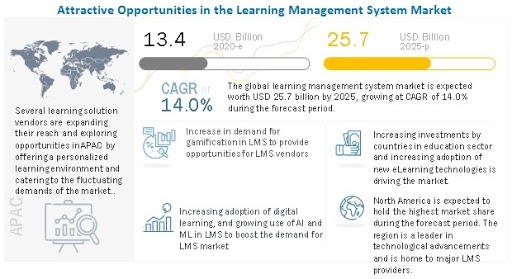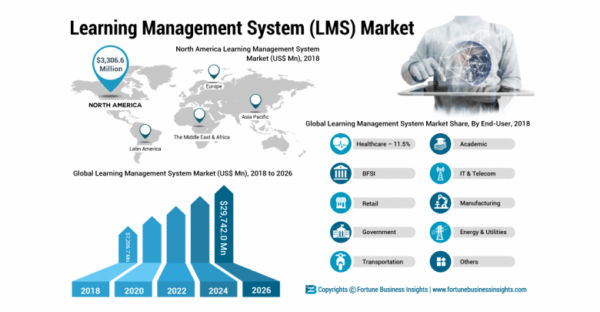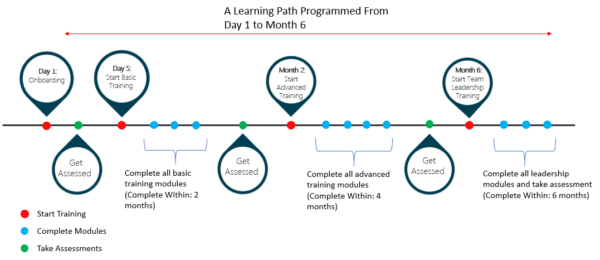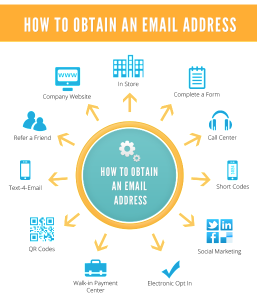Enterprises, learners, and organizations are making an evident shift from traditional learning to online learning. This apparent swing has initiated the need for a robust learning platform online that delivers apt knowledge to learners.
This is a complete guide to Learning Management Systems, which will help every organization and learner in understanding the tiniest details about using an LMS. So, let’s begin!
What is the Learning Management System?
Software that is utilized by the companies to develop, deliver, and track training to different parties, including clients, partners, and employees. However, until now, the word ‘training’ had a different meaning for us, and a picture of a classroom with an instructor teaching student would appear in our mind. However, the Learning Management System is different; it’s a software that different companies utilize to deliver training to the learners.
“LMS users are estimated to be around 73.8 million. Today, nearly 87% of active users are relying on web-based Learning Management System programs.”

What are the Key Functions of a Learning Management System?
The Learning Management System serves every organization differently. The role of LMS depends on every organization’s objective, their online training policies, and what they yearn to achieve with the Learning Management System. However, the common purpose of incorporating an LMS in any organization is to deploy and track online training leads.
Generally, an effective Learning Management System would have built-in authoring tools that allow developing online training materials without having a requirement of additional third-party software.
Simply put, a Learning Management System is a depository, where organizations can store, save, and track information. Anyone who has an account on an LMS will just need a login and password to access the online training resources. It doesn’t matter where you are and what’s the time at your location. All you need is an account on an LMS and your logins to access the information stored.

What are the Categories of Learning Management System Users?
Generally, LMS users fall into two categories, which are online learners and the eLearning team. The former one is those who utilize the LMS to participate in the online training courses. The latter ones are those who utilize the LMS to distribute the information and update online training content if needed.
Who All Can Get Advantage of a Learning Management System?
LMS is advantageous to different organizations, including training institutes, universities, educational institutions, and corporations alike. There are different organizations, who can experience the benefits of a quality Learning Management System platform.
How does an LMS help the Learners?
Right from the ‘registration’ process to ‘recording’ and ‘analyzing’ learner’s progress, everything is done by a Learning Management System. How does this really help the learners? Well, it helps them in finding the apt learning material, consume the right learning resources, adopt new skills, and gain as much updated knowledge as they can.
How does an LMS help the Organizations?
The organizations get a robust platform to keep their learners learning new training courses and identify & fill the skill gap that’s needed to grow your business in the long-run.
Coming back to the question, ‘who all can get the benefit of a Learning Management System,’ here are the following different organization types, who can utilize this platform to learn and grow.
- Educational & Training Institutes
- Businessmen building an online education business
- Firms aiming at developing employees’ skills, training partner or customers
- Trade Association & Non-profit organizations
- Organizations turning to custom learning systems
In case, yours is any of these organizations, you can surely rely on a robust Learning Management System to grow and enhance your firm and its learners.

Advantages of Relying on a Learning Management System?
Well, there are quite a few; all we need is the right LMS platform to make it count.
1. Apt Organization & Storing Huge Data
LMS allows you to gather and store all gigantic data in one place. That even makes handling such huge data easily, and even updating the materials, when needed. Generally, every Learning Management System does have advanced encryption, which lets you avoid any misuse and mishandling of the data.
2. Customizes Training Experience Online
LMS allows learners to utilize numerous learning paths and training resources. Hence, everyone gets customized online training, which is actually needed to enhance their skills and learning. A Learning Management System basically serves the learning needs of different learners based on their job roles, learning objectives, and skill upgradation need. Using an LMS, organizations can even allow the learners to unlock the navigation, which helps the organization’s learners in selecting their courses and training activities. That highly delivers more effective online training experiences & enhances satisfaction amongst the learners.
3. Monitors Learner’s Progress
Nowadays, almost every LMS software does have a built-in analytics reporting system. That makes it easy for you to track different aspects of the training program online. Besides, plug-ins and add-ons are always available (in case LMS deficiencies reporting capabilities) to boost the functionality of the LMS. A robust learning management system allows you the ability to track everything – right from the eLearning assessment outcomes to the learner’s engagement.
4. Boosts eLearning Accessibility
We are residing in the digital era, where learners are expecting online training resources on demand. Information, today, is available at the fingertips, for which we need to thank the existing gadgets and smartphones. A robust LMS will help you in deploying the right learning material and courses to the learners irrespective of their location and other demographic features. All they must have is their logins to enter into the Learning Management System to enhance their knowledge and skills.
5. Enhance Resource Distribution
LMS delivers multiple ways to help an organization deliver online training courses much more effectively. It will allow organizations to identify different facets of the online training program, which aren’t really meeting the expectations. One can identify that by scrutinizing the learner’s engagement, which, if, is low, is a sign that the organization needs to reexamine its online training module. The Learning Management System even helps in updating online learning assets more quickly.
What Features Build a Robust Learning Management System?
Different features when incorporated together make the most reliable and quality Learning Management System. Let’s see what really goes into making a highly scalable Learning Management System.
1. Responsive Design
Online training courses deployed by a cloud-based LMS allows everyone to enjoy something from the online training course. That includes all – right from those who use smartphones to those using any other device to access learning material. An LMS should be highly responsive, allowing you to develop a master layout, which can easily be customized further within a limited time. A highly robust Learning Management System allows fantastic display on different devices, based on the diverse needs of the users.

2. Analytics & Reporting
A highly robust Learning Management System helps you in monitoring the online training progress while helping you in adjusting the materials and courses if needed. A Learning Management System should feature an analytics and reporting system, which can help learners and even organizations in tracking performance and progress. Also, tracking progress helps in identifying the gap in the skills and performance of the organization and the learners. Hence, there is always a space for improving what lacks in the performances of both the learner and the organization.
3. eLearning Assessment Tools
Assessing the learning needs of the employees or the customers intermittently identifies the gaps. Hence, a Learning Management System should be capable of building eLearning assessment tools, which can help everyone assess their performances and progress while filling the gap, as soon as it is identified. Hence, your LMS should be offering you enough eLearning assessment tools to track whether you are on the right path or not.
4. Gamification Features
Different factors are needed to motivate different learners. Some require better knowledge to get going, while others require extra incentive to stick to the online training courses. Game mechanics is an active source of motivation for learners, which they receive in the shape of points, badges, and even leaderboards. The need is just to find out such a robust Learning Management System that offers you a built-in gamification feature, which will further assist in incorporating rewards too.
5. Social Learning Option
A robust Learning Management System will ensure that it even delivers social learning, which means the learners have the chance to interact with peers and disburse knowledge and experiences with them. For instance, many quality LMS now integrate social media tools, which helps learners in sharing what they are learning on the LMS. They can track online discussions, participate in them, and even incorporate news feeds into the course.
6. Support Tools
The Learning Management System should have different support tools too. How much support do different learners need? How intensive the learning material should be? Well, we can decide that based on how well we use the LMS. Using the LMS, you can identify how novice eLearning teams should be trained and how those already acquainted with certain skills and knowledge should be treated. Many even host online discussions, where everyone tries to deliver what they have learned. They simply connect, discuss certain topics, and share their knowledge. Hence, your LMS must have different courses with different intensity for multiple users.
How Should You Select a Learning Management System?
There are different factors involved in selecting a good learning management system, some of the most essential ones are here:
3 Main Routes to Selecting a Learning Management System are as follows:
- Developing your own
- Buying a ‘readymade’ solution
- Utilizing an Open-source solution
Always invest time in selecting your own route, so that the eLearning journey is smooth, saves you money, and diminishes the glitches that might happen in the learning management system, otherwise.

a) Developing Your Own Learning Management System
This one satisfies all minor requirements of both the organization and the users. However, building your own learning management system comes with its own pros and cons, which goes like this:
Advantages first – Building your own LMS will never let you compromise on the features, which are needed to train and educate the employees, partners, and customers. Besides, you have the upper hand when it comes to customizations in learning materials, without paying anything for the supportive tools. One doesn’t have to rely on the third part when upgrading the learning material and even manage the LMS.
Now, Disadvantages – Having your self-built LMS can lead to several downsides too. Such a learning management system can leave you on your own when it is about fixing the issues or upgrading the material in the courses. You might need to train people, in case the LMS lacks certain knowledge and training material. And, lastly, you will even need to invest numerous man-hours in the training and development process.
b) Buying a ‘Readymade’ Learning Management System
The other option is to invest in a ready-made learning management system. With such an off-the-shelf LMS, you can immediately get it running in the least time possible. However, certain pros and cons come with the ready-made learning management system. Here are those:
The Pros, first – The cost that has to be paid for building an LMS is way lower than that that incurred in building your own platform. Besides, it can be implemented as soon as you have purchased it. Hence, there is no waiting period to use the LMS. You can even get incessant security updates and support, which means no interruption in the learning process.
Now, The Cons – There is a higher probability of not getting every feature that your firm might need. You will even be ending up paying for features, which you don’t even need in the organization. Along with that, there is a limitation to what you can personalize too. Hence, there are a ton of cons that you might face when relying on a ready-made learning management system.
c) Utilizing an Open-Source Solution
The third option is the open-source solution, which is utilized by everyone. They can see, modify, and change the ‘source code.’ How does this exactly work? Well, this LMS can be used by anyone; they can use a renowned LMS and personalize it as per their needs. Besides, the open-source solution also comes with certain benefits, which are as follows:
i. Speedy Installation – When using the open-source LMS, you can consider it a hassle-free process, as it takes no time to get installed. It is just a matter of a few hours, and you will have your LMS ready.
ii. Secure & Reliable – Since it is created from a readymade solution, it is likely to be reliable and secure. Here, the global community of developers is modifying and enhancing the open-source software. Hence, one can completely rely on it.
iii. Diminished Cost – The open-source software is free to use. One can freely use it – everything from installation, management, updating, and hosting to hosting – all processes are done by a well-known LMS. Thus, you only pay for a few services and not everything, as in your self-built software.
iv. Flexibility – The branding and customizations can be done easily on this already existing LMS software, which means you are getting a quality LMS along with easy customizations to make it work for your business.
v. Hosting – LMS hosting is important – and some companies incorporate quality hosting as a part of their product.
vi. Support – Some open-source LMS allows you to enjoy unlimited support and training on running the software as well. Hence, open-source software can be highly beneficial, in case it delivers constant support and training as well.
The decision of selecting the apt LMS highly relies on the organization. It has to be considered what does your audience want, and what exactly do you wish to attain with the LMS.
How Incorporating LMS can Boost Sales, Staff Retention, and Customer Contentment?
A broad range of LMS integrations can help an organization achieve desired results. Right from customer relationship management to web conferencing, everything can be managed with LMS.
Right from enhancing customer satisfaction to managing content, everything is managed aptly with the LMS integration. But how do you know which integration is really profitable?
Here’s how incorporating LMS into your organization can help in boosting sales, customer contentment, and staff retention:
1. Enhance Employee Productivity
With an LMS easy login system, it is quite easy to enhance the employee’s productivity. Wondering how? Well, employees just take a minute to login to multiple platforms for performing everyday tasks. All they need is their email and the password to enter into the world of training material and courses. Hence, there are all the chances that they can focus on much more productive activities of their organization.
2. Solves Performance Problems
Sometimes, finding the root cause of performance or skill gap is tough. Even after scrutinization, it is difficult to find the exact reason why the employee’s performance is lacking. In such cases, LMS integrations, including SalesForce LMS amalgamated with other training and learning tools will help in addressing the issues. For instance, with the assistance of demos and simulations, one can easily figure out the reason behind the low sales. Hence, the learning management system along with its tools will help in identifying the real performance issues along with a proper solution for it.
3. Boosts ROI
Organizations that are when backed up by a robust learning management system have higher chances of boosting the ROI. Employees do have the convenience of getting easy access to training resources along with business analytics. That means. They keep an eye on everything that’s happening on the platform. Besides, your learning and development team can get the minutest details of real performances vs. the expected ones. The managers will have detailed reports and analytics of the performances, which helps in fine-tuning the skills and performances of the learners.
4. Manage Gigantic Data
Businesses do have large data to store and manage. However, it could be a challenge for organizations to manage such complex and huge data. In such a case, it is a wise decision to rely on a learning management system for organizing and storing big data. Learning management system integration delivers support in managing the training and other vital business data seamlessly. Besides, organizations can even merge LMS, CRM, and HR, which will make it a seamless process to identify the pain points in the organizations. Moreover, such huge and critical data is also secure with a good LMS, as a single sign-in is all you need to get into the platform.
5. Team Building
Learning management system fosters team-building via tools like web and video conferencing. It has become one of the most effective LMS integrations, though. There are different effective tools associated with LMS, including the calendar and other collaboration tools, which makes it easy for everyone to manage their deadlines and projects. Another reason to utilize a learning management system for your business is to foster peer support. Employees do have a lot to share when they are trained or trying new learning tools. Hence, they have the option to share their experiences and feedback in real-time.
6. Restructure Business Tasks
The LMS integrations streamline the internal processes of the organization. That makes the jobs of both the firm and the learners easy. Besides, when everything is restructured inside the organizations, it is easy to manage the performances and the individual progress as well. Apart from that, one can even focus on the potential areas that might lead to an improvement in business and performance. A robust learning management system shoves away the potential issues in the organization while focusing on productivity and deadlines. The need is just to invest in a quality LMS, which is easy to use and goes easily with your business needs.
Learning Management System Automation – Time Saver & Communication Booster
Many organizations are deterred by the boring and traditional ways of communication, which are still relied upon by many organizations. Besides, these tedious and slow communication modes waste time too, which is a big hurdle in the overall productivity and performance.
People barely believe when they are told that just two individuals can aptly look after almost more than 60,000 learners using one Learning Management System. But that’s true! Just imagine how much time is saved using such LMS. The need is just to get an easy-to-use LMS, which helps your organization in saving time and building better communication, without any hurdles.

Why is LMS Automation Vital for your Business?
Don’t be amongst the admins who are still manually relying on assigning learning material and assets to every individual, learner, employee, or intern. And, in case, you are still doing that, it is evident that you are relying on a timeworn LMS.
Learning Management System managers are well aware of the nightmare that is experienced with manual assignments. Learning needs are changing, and that needs highly accessible and scalable tools to manage those needs.
How is your organization managing when an employee is leaving the job or is being promoted? Well, that’s how you will figure out how traditional LMS is. Hence, the need of the hour is to invest in an automated LMS, which manages the assignments and other documents, when your employee is being promoted or leaving the organization.
Besides, a robust LMS can be relied upon for training thousands of learners at one time. Build groups and utilize the auto-assigned structure to manage everything simply.
Learning Management System Implementation – How the Journey Goes?

So, by now, you might have understood how LMS really works, its benefits, and why every organization should have it for their learners. Now, we must know how a learning management system is implemented so that the journey of an organization and a learner is seamless.
Preparation Stage
A successful Learning Management System implementation is possible when you are prepared for the same. Finally, when you have decided to implement a new learning system in the organization, it is evident that you will need to invest in different LMS integrations, tools, and solutions. There are hundreds of learning management systems to choose from. However, the need is to invest in the right one. Besides you need to invest time in researching – finding out about how many LMS exist in the market and which one is the best for your business needs. Just keep in mind the goals and deadlines of your business to ensure that everything runs in the right direction.
Searching for the Team
Once you have researched the market and figured out what suits the business, it is time to find the right team. It might be a tough process, especially if you haven’t implemented a Learning Management System before. Otherwise, it won’t be a task for anyone to build your eLearning team. So, in the former case, you will have to rely on some guidelines for utilizing the LMS, however, in case you have used it earlier, it would be easy for you to use the learning management system and build your team. Besides, the team’s size will rely on how big or small your firm is.
If you are just a one-person team, these people are, for sure, needed in the organization.
– Project Manager
Team leaders or project managers are vital to run any project. Organizing people and processes is important, which will help in easy accomplishments of the tasks, without having anyone to face any hurdle in the process throughout. The project managers manage the teams and the tasks so that everything runs smoothly in the right direction.
– IT Specialists
Of course, you will need some – it is the first time you are investing in technology like a learning management system. Hence, you will definitely need some IT specialists, who are all skilled and experienced in handling all IT related processes to avoid any hurdles throughout. It will not only save you a lot of time but also your efforts, which will speed up the regular tasks and help you in achieving the expected outcomes as soon as possible.
– eLearning Experts
Your team will even need some eLearning experts, who are constantly focused on the peculiarities of the eLearning. For instance, these experts need to be proficient in eLearning tools, models, and everything else related, so that there is no hurdle in the process of learning in the future. They will even manage the features needed in the Learning Management System, which is highly vital in the future.
Deadlines & Motives
Now, when your highly reliable team is ready, it is time for you to move further to attaining your business goals. All you need to do is create a new program along with all other details to be mentioned in the project. The teams need to be well aware of the timelines and business objectives. With the assistance of all team members, you will have to prepare a learning program that suits your learners, helps them in growing and attaining new skills, and boosting performance. Besides a robust Learning Management System will even allow you to communicate better with the channel partners, customers, and even the learners. All you need to do is put a clear picture of your business in front of every individual involved in the business.
Apart from that, you need to keep a SMART (Specific, Measurable, Achievable, Realistic, and Timeframe) framework in mind to make the LMS a success for your organization.
The implementation of a learning management system will be successful only when you are clear about your goals and the expected results. The analytics and performance charts will keep you on track, however, it needs a constant check and timely analysis to make things work for the organization and the learners.
The Takeaway Message
A Learning Management System acts as a backbone for any business that imparts learning. However, this backbone has to be chosen intelligently to ensure that all the parties involved are learning and growing along with enhancing their performances and skills in the long-run. Eventually, both the organization and the learners should be growing, which is possible only when you are acting wisely and actively in selecting, finding, and implementing the LMS. If it is your first time using a learning management system, you will have to be extra conscious about the processes, otherwise implementing LMS is not as tough as it seems. Just pick a quality LMS and manage everything properly to get fruitful results in the long run.
Business & Finance Articles on Business 2 Community
(113)
Report Post





